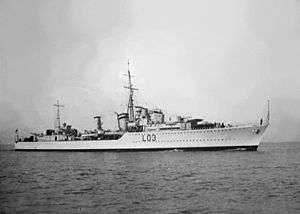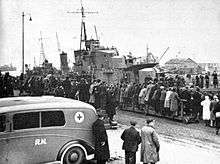HMS Cossack (F03)
 HMS Cossack under way in 1938 | |
| History | |
|---|---|
| Name: | Cossack |
| Namesake: | Cossack |
| Ordered: | 10 March 1936 |
| Builder: | Vickers-Armstrongs |
| Cost: | £341,082 |
| Laid down: | 9 June 1936 |
| Launched: | 8 June 1937[1] |
| Completed: | 10 June 1938 |
| Identification: | Pennant number: L03, F03 & G03 successively |
| Fate: | Sunk, 27 October 1941 |
| General characteristics (as built) | |
| Class and type: | Tribal-class destroyer |
| Displacement: | |
| Length: | 377 ft (115 m) (o/a) |
| Beam: | 36 ft 6 in (11.13 m) |
| Draught: | 11 ft 3 in (3.43 m) |
| Installed power: |
|
| Propulsion: | 2 × shafts; 2 × geared steam turbines |
| Speed: | 36 knots (67 km/h; 41 mph) |
| Range: | 5,700 nmi (10,600 km; 6,600 mi) at 15 knots (28 km/h; 17 mph) |
| Complement: | 190 |
| Sensors and processing systems: | ASDIC |
| Armament: |
|
HMS Cossack was a Tribal-class destroyer named after the Cossack people of the Russian and Ukrainian steppe. She became famous for the boarding of the German supply ship Altmark in Norwegian waters, and the associated rescue of sailors originally captured by the Admiral Graf Spee. She was torpedoed by U-563 on 23 October 1941, and sank 4 days later, on 27 October.
Construction and career
She was laid down at the Walker Naval Yard of Vickers-Armstrongs in Newcastle upon Tyne on 9 June 1936, launched on 8 June 1937 by Mrs. S. V. Goodall, commissioned on 7 June 1938 and completed on 14 June 1938. During her trials Cossack made 36.223 knots (67.085 km/h; 41.685 mph) at 366.4 RPM with 44,430 shp (33,130 kW) at 2,030 long tons (2,060 t).[2]
Altmark incident

Cossack's first action was on 16 February 1940, under the command of Philip Vian. This was the Altmark Incident in Jøssingfjord, Norway which resulted in the freeing of the Admiral Graf Spee's prisoners who were being held aboard the supply ship Altmark and the death of eight crew members of the German ship.
In the Incident the German tanker rammed her with the stern in an angle of about 30° at the altitude of her bridge and pressed the destroyer towards the fiord wall. The Norwegian officers present later reported, that only the mass of ice piled up averted the destroyer to crash onto the rocky shore. The powerful engines of the destroyer made her escape from the squeeze possible.[3] Cossack arrived at Leith on 17 February with the 299 freed prisoners.[4] She had to be docked for her propellor and A-brackets to be checked in case they had been damaged by the thick ice in the fiord. They were unharmed, but her stern plating had to be repaired where it had been bumping against Altmark.[5]
The Norwegian Government subsequently protested at Cossack's breach of Norway's neutrality and demanded the return of the prisoners, with the German government further protesting at the act of violence committed against Altmark.[6]
Second Battle of Narvik
Cossack participated in the Second Battle of Narvik in April 1940. Later that year, she was part of the force which was assigned to hunt for a German surface raider that had been reported breaking out into the North Atlantic. The force consisted of the battlecruiser Hood, the light cruiser Edinburgh, and the destroyers Electra, Echo, Escapade, and Cossack. The report turned out to be false, so after spending a week at sea, including Christmas Day, she returned to port on New Year's Eve.
Chasing Bismarck
In May 1941, she participated in the pursuit and destruction of the German battleship Bismarck. While escorting Convoy WS-8B to the Middle East, Cossack and four other destroyers broke off on 26 May, and headed towards the area where Bismarck had been reported. They found Bismarck that evening and made several torpedo attacks in the evening and into the next morning. No hits were scored, but they kept the Bismarck's gunners from getting any sleep, making it easier for the battleships to attack the Bismarck the next morning.
Loss
On 23 October 1941, Cossack was escorting a convoy from Gibraltar to the United Kingdom when she was struck by a single torpedo fired by the German submarine U-563 commanded by Klaus Bargsten. She was taken in tow by a tug from Gibraltar on 25 October, but the weather worsened and the tow was slipped on 26 October. Cossack sank in the Atlantic west of Gibraltar on 27 October 1941. 159 of her crew were lost.
Notes
References
- Brice, Martin H. (1971). The Tribals. London: Ian Allan. ISBN 0-7110-0245-2.
- English, John (2001). Afridi to Nizam: British Fleet Destroyers 1937–43. Gravesend, Kent: World Ship Society. ISBN 0-905617-64-9.
- Friedman, Norman (2006). British Destroyers and Frigates, the Second World War and After. Annapolis, Maryland: Naval Institute Press. ISBN 1-86176-137-6.
- Haarr, Geirr H. (2010). The Battle for Norway: April–June 1940. Annapolis, Maryland: Naval Institute Press. ISBN 978-1-59114-051-1.
- Haarr, Geirr H. (2009). The German Invasion of Norway, April 1940. Annapolis, Maryland: Naval Institute Press. ISBN 978-1-59114-310-9.
- Hodges, Peter (1971). Tribal Class Destroyers. London: Almark. ISBN 0-85524-047-4.
- Lenton, H. T. (1998). British & Empire Warships of the Second World War. Annapolis, Maryland: Naval Institute Press. ISBN 1-55750-048-7.
- March, Edgar J. (1966). British Destroyers: A History of Development, 1892-1953; Drawn by Admiralty Permission From Official Records & Returns, Ships' Covers & Building Plans. London: Seeley Service. OCLC 164893555.
- Rohwer, Jürgen (2005). Chronology of the War at Sea 1939–1945: The Naval History of World War Two (Third Revised ed.). Annapolis, Maryland: Naval Institute Press. ISBN 1-59114-119-2.
- Whitley, M. J. (1988). Destroyers of World War Two. Annapolis, Maryland: Naval Institute Press. ISBN 0-87021-326-1.
- R. K. Lochner: Als das Eis brach: Der Krieg zur See um Norwegen 1940. Heyne Verlag, München 1983.
External links
| Wikimedia Commons has media related to HMS Cossack (F03). |